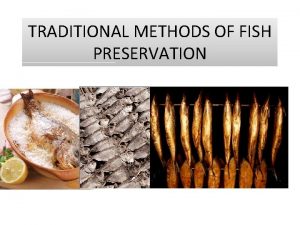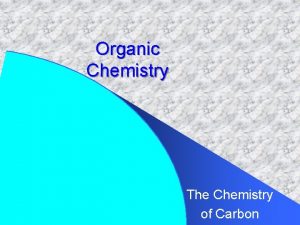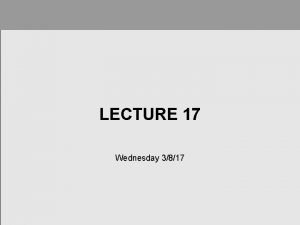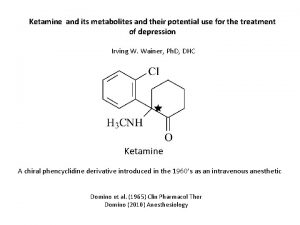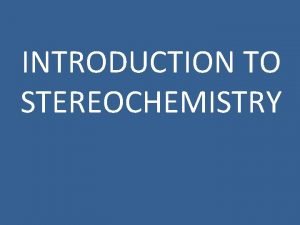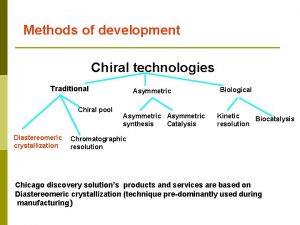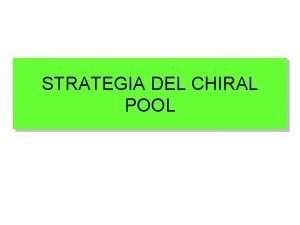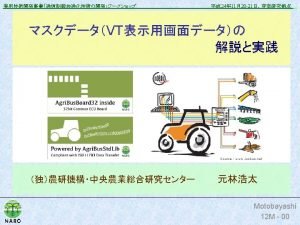Methods of development Chiral technologies Traditional Chiral pool









- Slides: 9

Methods of development Chiral technologies Traditional Chiral pool Diastereomeric crystallization Asymmetric synthesis Catalysis Biological Kinetic Biocatalysis resolution Chromatographic resolution Chirosolve products and services are based on Diastereomeric crystallization (technique pre-dominantly used during manufacturing)

CDS chiro Kits - Features/Benefits • 384 combinations of resolving agents/solvents to screen against in parallel; 4 kits per racemate; each with 96 vials • • • Very little racemate needed per experiment (0. 03 mmol per vial) • • Consistent results; elimination of human errors Exhaustive screening offers unbiased results; increases project success Researchers do not have lot of sample to work with during early research Vials and rack made of polypropylene; chemically inert and withstand extreme temperature • • Whole experiment can be done inside the rack without taking out vials No additional setup required; kits are ready to use out of the box

CDS chiro Kits - Features/Benefits • Designed to screen any racemate against reagents and solvents within 24 hours for optimum resolution • Racemate can be acid, base, alcohol, aldehyde, ketone or amino acid • Acid and Base resolving Agents and Solvents chosen on the following criteria: • • • Literature precedent for optimum crystallisation Compliance/traceability Availability and cost Environmental/FDA regulations (i. e. no acetone due to shipping issues) Conveniently designed for easy robotic manipulations for high throughput labs • Kits come with peelable seal or pierceable cap-mat to accommodate direct injection of racemate by liquid dispensers

CDS chiro Kits - Features/Benefits • Acid Series 1 -4 are used to resolve racemic bases and amino acids (free and protected) • • Pre-processing is required for amino acids via esterification Base Series 1 -4 are used to resolve racemic acids, alcohols, aldehydes, ketones, as well as protected amino acids • • Pre-processing of alcoholic racemate into acidic moiety with succinic anhydride or phthalic anhydride Pre-processing of protected amino acid through formylation Please refer to http: //www. chirosolve. com/howtousekits. php for details

CDS Chiro Kits Advantage • • Short Term • • • Consistent results; elimination of human errors Exhaustive and parallel screening increases project success Considerable time saving, optimization of resource cost saving High versatility of kit will allow for increased project success Easy identification and accurate result documentation Long Term • • • Minimise research costs by finding the optimum strategy to employ when dealing with chiral separation Reduce time-to-market by streamlining your research processes Achieve efficacy Expand research options Unbiased results ensure full exploration of separation methods

Diastereomeric Crystallization Sample separation (+/-)Ibuprofen (-) phenethyl amine Diastereomeric salt (-) crystalline and (+) filtrate 2 -propanol = + + Treat with strong acid and separate out Scale-up to identify # of re-crystallizations needed to get target purity (-)isomer (crystalline) (+)isomer (filtrate)

Resolution using Chiro. Solv® CDS Kits Liquid racemate kit (384 unique combinations) Solid racemate kit Racemate: acid, + base; or neutral derivatized to acid/base moiety Further optimization to minimize use of toxic reagents/solvents; Increase energy eficiency Scale-up for chosen vials to identify number of re-crystallization steps to achieve target enantiomeric purity Heat till homogeneous solution; Identify vials with residue Cool to get crystals; may have to freeze to 0○c; may need crystal initiation Analyze vials with crystals; HPLC reading separately for crystals and filtrate Choose best 2 vials with high yield and putiry

Types of Kits • Kits for liquid racemates: Each vial contains a unique mixture of resolving agent and solvent; ready to use; all you add is the racemate • Kits for solid racemates: Vials of the kits contain resolving agents; while the solvents are provided in separate plate. This allows scientists to dissolve solid racemate in a “transport solvent” for easy dispensing into vials; evaporate “transport solvent”; then add Chiro. Solve solvents • Kits with strong acids: Weakly base racemates need to be screened against strongly acidic reagents • Secondary screening kits with different derivatives of the same resolving agent • Kits with flat-bottom glass vials that can be directly used for HPLC analysis

CDS chiro kits can be used. . . • • • To identify crystallization conditions during manufacturing During pilot studies; proof of concept stage To obtain higher purity when other chiral separation methods are used during development stage
